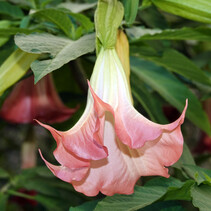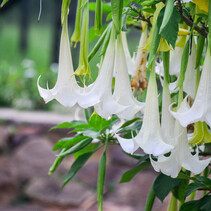Brugmansia - Angel's trumpet - Wonderfully fragrant tub plant
How is an angel trumpet planted correctly?
Under normal conditions, angel trumpets are planted in a tub. They need a place in the sun, although light semi-shade is also accepted. Due to its size and bushy growth, an angel trumpet is susceptible to wind. They evaporate a lot of moisture through the leaves, the substrate dries out and loses weight. As soon as a stronger wind blows, the plant falls over. To keep the plant stable, a plastic tub with a large diameter is recommended. Apart from stability, the angel trumpet has sufficient root space this way. It is also easier to move due to the low weight of the pot and cannot stick to the wall of the pot either. When choosing the pot, keep in mind that small pots limit growth and there is a danger of drying out. However, it is important that water can drain well. Large holes and potsherds of earthenware at the bottom prevent accumulating moisture. The same goes for a well-drained substrate. Breathable additives such as clay, lava pebbles or other clay-shaped granules increase the permeability of normal potting soil.
Fearless gardeners plant angelica in the garden. In full soil, the beautiful tub plants grow significantly better. However, digging them out before winter is urgently recommended. Before the first frost, the angel trumpet is transplanted into a tub and placed in the winter quarters. Cutting off the roots does not harm the angel trumpet.
How is an angel trumpet cared for?
The large leaves of the angel trumpet evaporate water profusely. Regular and pervasive watering is necessary during spring and summer months. On hot days, watering should usually be more frequent (e.g. in the morning and evening) A lack of water is visible by drooping leaves and their wilting. Blooming trumpets make the shrub less attractive. These are removed as soon as the flowers turn brown.
Rapid growth needs a lot of nutrients, as does the highly decaying angel's trumpet. Fertilise every 3 to 4 weeks with a liquid complete fertiliser. This fertilisation is not necessary if a depot fertiliser, which provides long-term fertilisation, is mixed into the substrate when transplanting in spring. From high summer, fertilising is reduced and not done at all in late summer. The plants use the dormant time until overwintering to strengthen the wood.
Pests rarely arise on angelica. Under glass, e.g. just before the plant emerges from winter quarters, aphids or leaf bugs may appear. Silver dots on the leaves indicate, during a dry hot summer, an attack with spider mites. Planted out in the open ground, the roots are eaten by the lapsnout beetle.
How does the angel trumpet overwinter?
As soon as the first frost announces itself, it is time to prepare the angel trumpet for winter. Inplanted specimens are dug out. If they are too large, they are pruned and planted in a pot. Plant parts that possess recognisable pests are removed. Wintering can follow in a light place at 5 to 15° C. Favoured is a conservatory, stairwell or light rooms. Often the angel trumpet then retains its leaves and even continues to flower. Sensitive noses remove the flowers, as the scent is intense and pungent. For dark overwintering, the temperature should not exceed 5° C. If the temperature is higher, plant growth starts with poor light conditions. In such a situation, diseases and pests may develop. Regular control deflects such problems. Before the plant goes inside, the wooden branches are shortened by a third or to half.
In winter, little to moderate watering is done. The substrate should not dry out and may be slightly moist.
In a greenhouse or conservatory, angel trumpets can tolerate higher temperatures as early as March. They sprout and the start of the flowering period recedes to the end of May. After the danger of frost has passed, the plants are first moved to a shady spot. An angel trumpet needs at least 14 days to firm up the leaf tissue and get used to the sun again.
How is an angel trumpet pruned?
Pruning is not necessary during the growth period of an angel trumpet. The plants naturally form healthy growth with sufficient buds. Pruning is done before the plant overwinters, ideally a few days before it moves. The pruned areas can dry out better in the fresh air.
Above the branches, an angel trumpet carries the buds. Branches are only partly shortened and not pruned too far into the wood. If too much pruning is done, it slows growth or weakens bud formation.
If only a dark winter quarter is available, branches are evenly shortened by a third to a maximum of half. Soft branches shot out are shortened to one or two leaves after winter.
How is an angel trumpet propagated?
Pure varieties can be sown in spring from at least 15°C. Simpler is propagation by half-grown cuttings in late spring. In this work, it is necessary to wear gloves and avoid intensive contact with the plant.
How can an angel's trumpet be used?
An angel trumpet is a beautiful plant for the tub or in the garden bed. They stand out for their large funnel-shaped flowers, which charm the whole environment with their intense fragrance. In pots, they adorn a larger balcony or terrace. Planted out, they are eye-catchers in a larger garden bed or in borders.
The colours depend on the variety and species:
Brugmansia arborea - white-flowering variety with large trumpet-shaped flowers
Brugmansia aurea - angel trumpet with yellow funnel-shaped flowers
Brugmansia sanguinea - orange-red odourless flower with yellow veins
Brugmansia versicolor - often white-flowering variety which can turn to an orange or peach colour.
When is the flowering period of an angel trumpet?
The flowering period of an angel trumpet starts in full summer and lasts until frost in late autumn. Plants grown under glass bloom significantly earlier, as early as the end of May.
Is an angel trumpet poisonous?
All plant parts of an angel's trumpet are highly toxic. Their use as well as intensive plant contact can cause strong poisoning. It is therefore necessary to wear gloves during any maintenance on the plant. In Indian shamanism, an angel trumpet is a medicinal plant with hallucinogenic effects. Its use is life-threatening, as depending on the location, the content of toxic tropane alkaloids varies from plant to plant.
Further information
An example plant because of its floral splendour can be admired in many gardens in summer: the angel's trumpet. The large trumpet-shaped flowers catch the eye from afar and the enticing scent caresses the nose. A blooming feast for the eyes, some of the flowers remain on the plant until frost and are a delight for any gardener or onlooker. The angel trumpet belongs to the genus brugmansia. The 9 evergreen tree and shrub varieties are native from the southern tip of North America to South America. Angel's trumpet used to belong to the thorn apple (Datura) and is still erroneously called so today. Both varieties are indeed similar. The flowers are about the same, so is the natural range, and they are both highly poisonous nightshade plants (Solanaceae). But still not the same.
Angel's trumpet forms a shedding branch with alternate, often toothed leaves. From summer onwards, they form large drooping funnel-shaped flowers with receded tips. Depending on the species, the flowers are white, yellow, pink or red. Its special feature is the long flowering season, which can continue until frost in late autumn.
In the garden, angel trumpets are mainly kept in a tub. They adorn a large balcony or terrace, are deployed with pots in beds or planted in the open ground. An angel trumpet planted in the open ground develops as a beautiful giant plant. The problem, however, is that the plants cannot overwinter outdoors in most regions. In a very mild and sheltered location, an angel trumpet may be able to overwinter with thick winter protection, but this is usually an exception.
There is hardly any other plant that blooms as beautifully as this beguiling wonder plant, making it the pride of every gardener. As beautiful as the angelica trumpet is, it is also poisonous. Unnecessary plant contact should be urgently avoided. Under no circumstances should plant parts be consumed. Even the smallest dose leads to severe poisoning. When maintaining this plant, wearing gloves is therefore essential.








